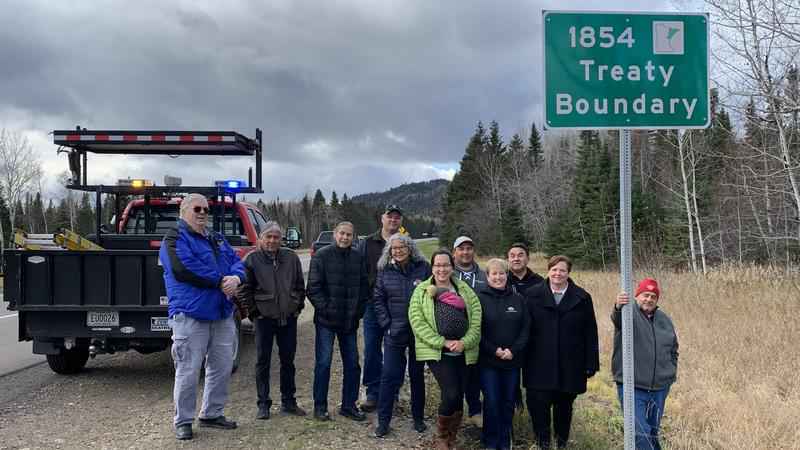New road signs mark boundaries of 1854 Treaty

Tribal leaders and MnDOT officials unveiled the first sign marking the border of the 1854 Treaty on Monday.[MnDOT]
New road signs are being installed in northeastern Minnesota to mark the boundary of the 1854 Treaty between the United States and three Anishinaabe nations.
The first sign was installed this week next to the southbound lanes of Highway 61 just south of the Canadian border, near Grand Portage State Park. 11 more signs will be installed, including along I-35 near Sturgeon Lake and U.S. Highway 53 in Duluth and near Cook (see below for complete list).
The 1854 Treaty includes the Grand Portage Band of Lake Superior Chippewa, Bois Forte Band of Chippewa, and Fond du Lac Band of Lake Superior Chippewa. Tribes retained the rights to hunt, fish and gather in the ceded territory.
The first sign was installed in a ceremony attended by leaders from the three bands and state transportation leaders.
"It is something that was long overdue. When people enter the 1854 Treaty area they will know where they are and, hopefully, educate themselves about treaties," Grand Portage Chairman Robert Deschampe said in a news release distributed by the Minnesota Department of Transportation.
MnDOT worked with the Advocacy Council for Tribal Transportation to acknowledge land ceded by tribal governments by treaties.
The 1854 Treaty was one of a half-dozen treaties that ceded territory in the Northland. The 1854 Treaty area is bordered by the 1837 Treaty to the south and to the west by treaties signed in 1855 and 1866.
RELATED STORY: Red Cliff gets Wisconsin’s first dual-language road sign
Signs marking the boundaries of the 1854 Treaty are being put up at these locations:
• I-35 (near Sturgeon Lake)
• Highway 2 (near Floodwood)
• Highway 23 (near Duquette)
• Highway 27 (west of Moose Lake)
• Highway 37 (near Hibbing airport)
• Highway 53 (entering Duluth from Superior)
• Highway 53 (near Cook)
• Highway 61 (near Canadian border)
• Highway 65 (two signs west of Sturgeon Lake)
• Highway 169 (near Chisholm)
• Highway 210 (near Tamarack)